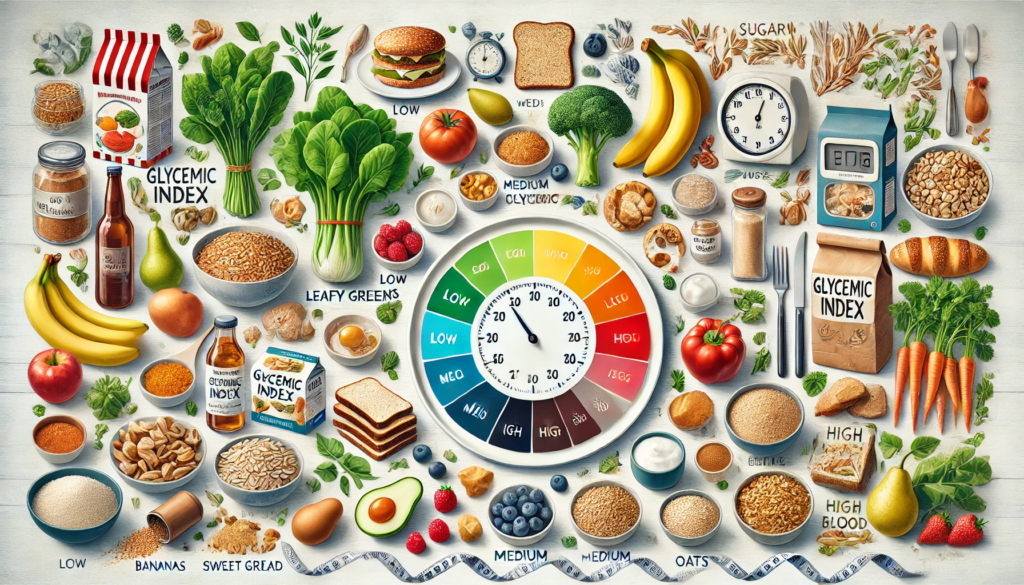The glycemic index (GI) is a valuable tool for understanding how different foods affect blood sugar levels. By ranking foods based on how quickly they raise blood sugar, the GI helps individuals make informed dietary choices, particularly those managing diabetes or seeking to maintain stable energy levels. This guide provides an overview of the glycemic index, its importance, and practical tips for incorporating low-GI foods into your diet.
What is the Glycemic Index?
The glycemic index measures how quickly carbohydrate-containing foods raise blood sugar levels after consumption. Foods are ranked on a scale from 0 to 100, with pure glucose assigned a value of 100. The GI categorizes foods into three main groups:
- Low GI (55 or less): Foods that cause a slow and gradual rise in blood sugar. Examples include leafy greens, legumes, and whole grains.
- Medium GI (56-69): Foods that cause a moderate increase in blood sugar. Examples include bananas, sweet potatoes, and oats.
- High GI (70 and above): Foods that cause a rapid spike in blood sugar. Examples include white bread, sugary snacks, and potatoes.
Importance of the Glycemic Index
1. Blood Sugar Management
The GI is particularly useful for individuals with diabetes or insulin resistance, as it helps them choose foods that have a minimal impact on blood sugar levels. Consuming low-GI foods can prevent sharp spikes and crashes, promoting more stable blood sugar levels.
2. Weight Management
Low-GI foods tend to be more filling and can help control appetite, making them beneficial for weight management. They can prolong satiety and reduce the likelihood of overeating, aiding in weight loss or maintenance.
3. Improved Energy Levels
Foods with a low GI provide a slower release of energy, preventing energy crashes that often follow the consumption of high-GI foods. This steady energy supply can enhance physical and mental performance throughout the day.
4. Reduced Risk of Chronic Diseases
A diet that prioritizes low-GI foods may lower the risk of developing chronic conditions such as type 2 diabetes, heart disease, and certain cancers. These foods are often rich in fiber, antioxidants, and other nutrients that support overall health.
Tips for Using the Glycemic Index in Your Diet
1. Prioritize Low-GI Foods
Incorporate more low-GI foods into your diet, such as:
- Leafy Greens: Spinach, kale, and Swiss chard
- Whole Grains: Quinoa, barley, and brown rice
- Legumes: Lentils, chickpeas, and black beans
- Fruits: Berries, apples, and pears
2. Combine Foods
Combine high-GI foods with low-GI foods to moderate the overall glycemic impact of a meal. For example, pair white rice with vegetables and lean protein to slow down digestion and reduce the blood sugar response.
3. Be Mindful of Portion Sizes
Even low-GI foods can raise blood sugar if consumed in large quantities. Practice portion control to manage calorie intake and maintain balanced blood sugar levels.
4. Choose Whole and Minimally Processed Foods
Whole foods are generally lower in GI than processed foods. For example, whole fruits have a lower GI compared to fruit juices, and whole grains are lower in GI compared to refined grains.
5. Consider the Glycemic Load (GL)
The glycemic load (GL) considers both the GI and the amount of carbohydrates in a serving of food. It provides a more comprehensive picture of a food’s impact on blood sugar levels. Low-GL foods are preferable for maintaining stable blood sugar.
Conclusion
The glycemic index is a helpful tool for managing blood sugar levels and promoting overall health. By understanding the GI of foods and making informed dietary choices, individuals can better control their blood sugar, manage weight, and reduce the risk of chronic diseases. Incorporating a variety of low-GI foods into your diet, along with mindful eating practices, can lead to more stable energy levels and improved well-being.
Frequently Asked Questions
Can I eat high-GI foods if I have diabetes?
While it’s best to limit high-GI foods, they can still be included in moderation, especially when combined with low-GI foods to balance the meal’s overall effect on blood sugar. It’s essential to monitor blood sugar levels and consult with a healthcare professional for personalized advice.
Are all low-GI foods healthy?
Not all low-GI foods are inherently healthy. For example, some low-GI foods may still be high in unhealthy fats or sugars. It’s important to consider the overall nutritional profile of a food, not just its GI.
How accurate is the glycemic index?
The GI can vary based on factors such as ripeness, cooking method, and food combination. While the GI provides a general guideline, individual responses to foods can differ. It’s best to use the GI as one tool among others for managing diet and health.
Can the glycemic index help with weight loss?
Yes, low-GI foods can help with weight loss by promoting satiety and preventing overeating. However, weight loss ultimately depends on a combination of factors, including overall calorie intake, physical activity, and lifestyle habits.
Is the glycemic index relevant for non-diabetics?
Yes, the GI can be beneficial for non-diabetics as well. It can help maintain stable energy levels, prevent excessive hunger, and support a balanced diet, contributing to overall health and well-being.
What are some common misconceptions about the glycemic index?
One common misconception is that all high-GI foods are unhealthy and should be avoided. While it’s important to limit high-GI foods, they can still be part of a balanced diet when consumed in moderation and combined with low-GI foods. Another misconception is that low-GI foods are always low in calories, which is not necessarily true. It’s crucial to consider both the GI and the overall nutritional content of foods.



